A Beginner’s Guide to the Zettelkasten Method
The smart note-taking method that popularized personalized knowledge management

The enormous amount of data produced per day is mad. We consume so much information on a daily basis, it’s no wonder many suffer from information overload.
Taking a tour through our brain would be like aimless meandering through a gigantic archive of information, files, and references. It’s no wonder that when we find interesting information we wish to retain, we either write it down on a notepad, put it on a sticky note on our desk, or save it in a digital file on our computer.
What’s the Problem with Note-Taking?
Sadly, most of the time, those ideas and information get forgotten and lost. Without proper organizational structure, your data can quickly become a pile of chaos and due to the overwhelming amount, regularly sorting and organizing your notes is the only way to keep them usable.
Similarly, how often do we take notes intending to utilise the information in the future, only to forget they even exist later on? Pieces of information without a clear description of their original intent for keeping or collecting it in the first place results in an assortment of miscellaneous information without any connection to a train of thought.
For those seeking to master knowledge building and transform their thinking, the Zettelkasten system is a great starting point.
What Is the Zettelkasten method?
The Zettelkasten method is a personal strategic process for thinking and writing. As one of the most effective knowledge management methods, it can best be described as an organization system that helps you organize your knowledge while working (studying or researching)
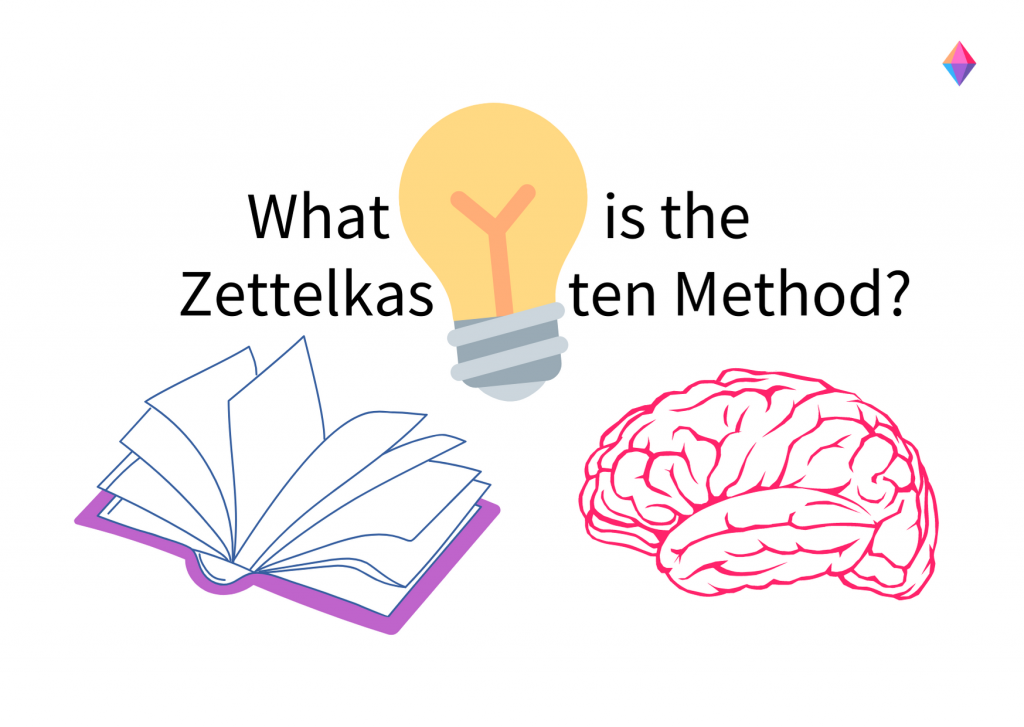
.
What makes the Zettelkasten method so great is that the system not only helps you store and organize your knowledge but also improves your memory and knowledge retention. Developing knowledge relationships significantly improves memory recall, and forming them also trains your mind to see patterns.
We need to understand how our minds work so we can work our minds better.
— Jim Kwik, mind coach and author of Mindvalley’s Superbrain Program
The Zettelkasten method encourages you to connect the dots between different trains of thought and knowledge. The steps facilitate our intrinsic ability to generate new connections between ideas and thus increase our knowledge and productive output.
The Zettelkasten method is good for when you want to:
- Systematically organize important information
- Find information again, even years later
- Develop your own ideas
In short, the Zettelkasten method is an integrated system for dealing with knowledge in your life and acts as an amplifier of your endeavors in the realm of writing and knowledge management.
What Is a Knowledge Management System?
Knowledge management (KM) is the process of creating, sharing, using, and managing knowledge and information. The main objective is to make the best use of existing knowledge.
When creating a personal knowledge management system, you ultimately develop a system and structure for organizing your ideas, thoughts, and information in a way that suits your thinking. In a way, you develop a web of knowledge and build up a “second brain” of all the information that you collect to help fuel an emergent approach to thinking.

Set up your personal knowledge management system.
Try our all-in-one project management software for free now!
Definition of Zettelkasten
Zettelkasten is a german word which translates to ‘note box’. The definition explains what material to work with and the filing system used. Let’s break it down into its parts:
A ‘zettel’ is a slip or note of paper. Information we wish to keep gets written on a Zettel. A classic form of a Zettel is a sticky note, an index card, or a piece of notepad paper for writing down your thoughts.
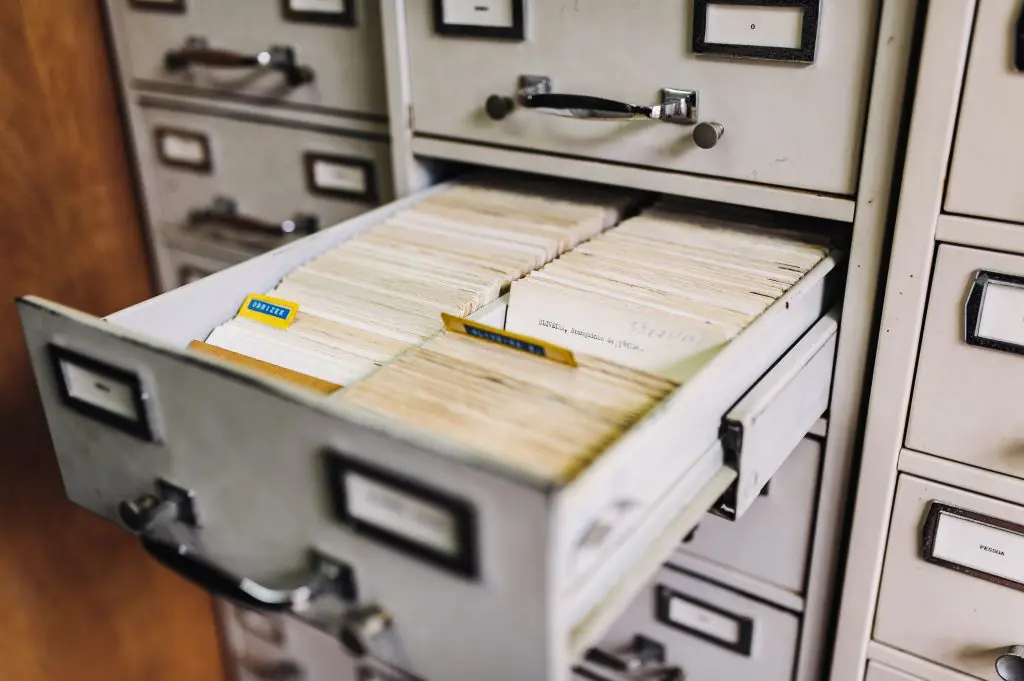
The word ‘kasten’ literally translates to box. In this context, however, it’s specifically an index card box. Index card boxes allow for an organized filing system keeping like-minded notes or zettel grouped and categorized in one place.
Following the definition, the Zettelkasten method can be explained as an index card knowledge management system that helps you to retain information that resonates with you, which you then organize, identify, and categorize, to ultimately convert into creative output.
In short, a Zettelkasten is simply a framework to help organize your ideas, thoughts, and information. By relating pieces of knowledge and connecting information to each other (by way of hyperlinking), you are replicating a train of thought. By establishing relationships between pieces of knowledge, you are helping retain consumed information allowing your thinking process to grow organically.
Who Is Niklas Luhmann?
Niklas Luhmann is the brain behind the system. The german sociologist is the founder of the smart note-taking and knowledge management system, the Zettelkasten method. He was extremely productive in his career, writing 70 books and more than 400 scholarly articles!
As a researcher, Luhmann was constantly reading and learning. In order to build upon his existing knowledge, he developed the systems theory we know as Zettelkasten today. Luhmann focused on understanding the information he read and making connections to existing information. For this, he used a paper-based system to categorize all the information he read and collected.

Luhmann collected information on a Zettel, categorized and filed it appropriately in his archive, which was indeed a piece of furniture with lots of drawers. He meticulously built a web of his knowledge that helped him retrieve information and develop new ideas efficiently.
To translate Luhmann’s Zettelkasten method to our digital age, his method of organization is an analogue system to what we now know as hyperlinking. Thus, the Zettelkasten system can be likened to or described as the first Wiki.
Zettelkasten Method Explained
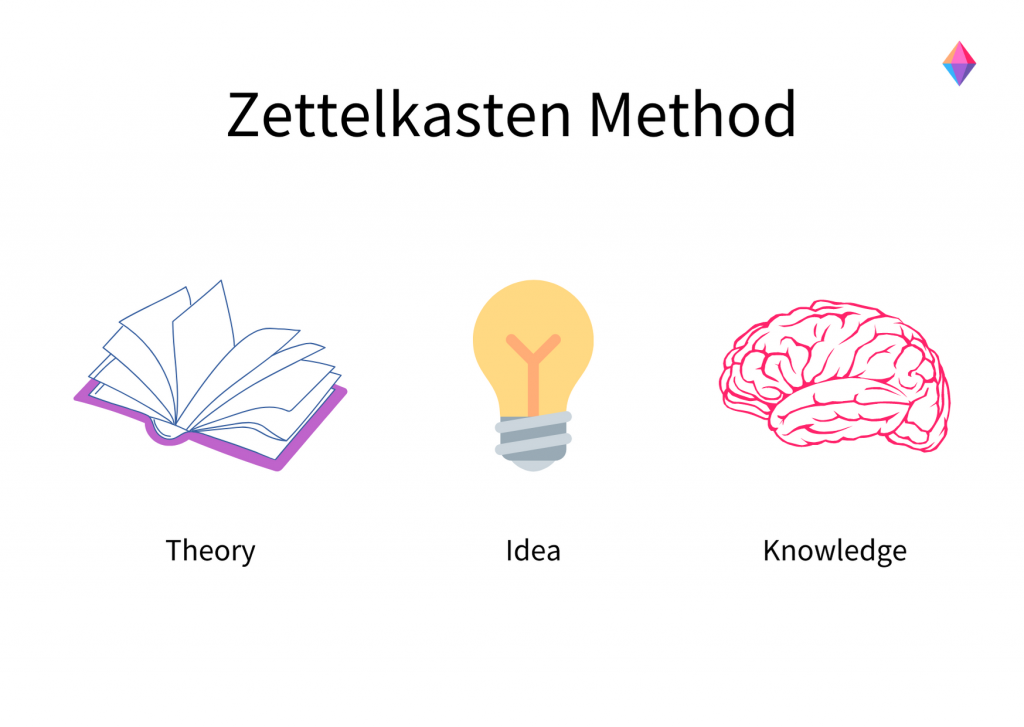
How Does the Zettelkasten Method Work?
The Zettelkasten method helps you collect and organize your thoughts, ideas, and information in a structured or categorical way. Following the steps and technique, you can build upon your existing knowledge and create a knowledge archive of your files and information that are a near-enough replica of the system of how your brain works.
Zettelkasten method comprises three main types of notes:
- Literature Notes
- Reference Notes
- Permanent Notes
Each note has a distinct objective and serves a specific function. Other types of notes include fleeting notes and hub notes.
Types of Notes
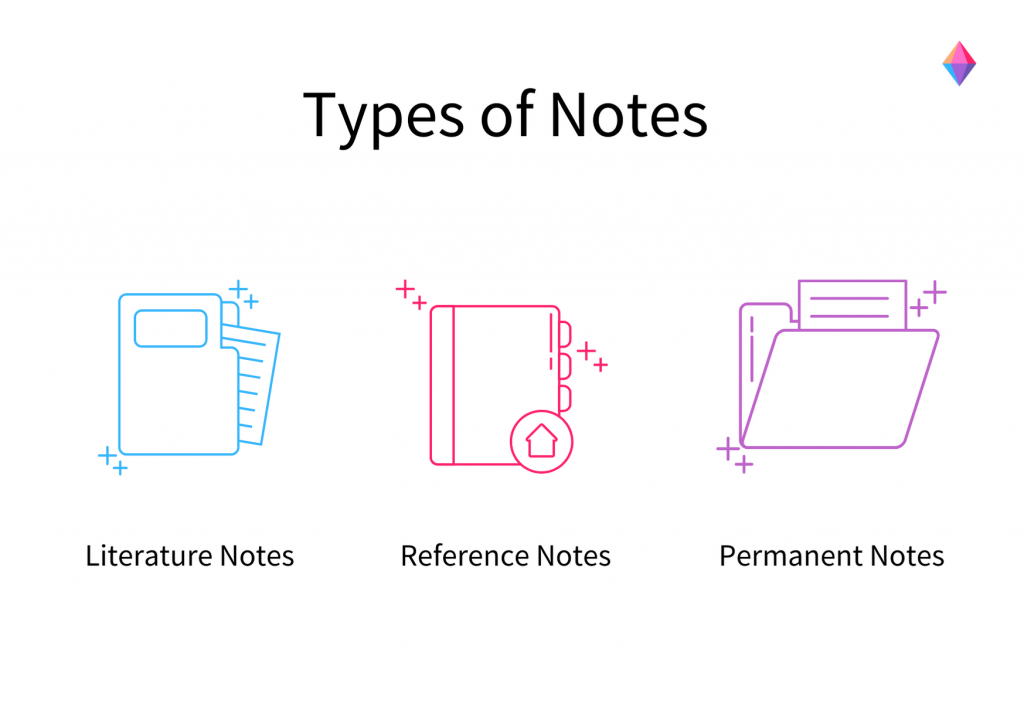
Literature Notes
Oftentimes when working or reading for leisure, there’s a particular text we either wish to highlight or jot down for future reference. Literature Notes are the notes you make as comments to the text you have selected or marked down.
Taking literature notes adds context and helps you remember the thoughts you had when reading or writing down the information. The whole point of adding comments to the text you highlight is to help you summarize the point of the text, to include your thoughts and your key takeaways from it.
The worst feeling when researching and taking notes is finding notes you previously made without any helpful context as to why you wrote the information down in the first place. Taking good notes is important so you don’t ever have to double back on your work.
Tip: It’s best to write down more information than later necessary.
For research purposes, make it a habit to include the book title, author, chapter, and page number. If you find yourself needing further context than your comment and notes provide, you won’t have to search the entire book to find the exact location you referenced to. Instead, you can immediately open to the right chapter your note addresses.
Reference Notes
The technique of grouping information, organizing ideas into categories, and creating tags to help you find grouped information at a later stage is the art of reference notes. When we reference something, it is safe to say that the topic or idea we are writing about is part of a bigger topic or is information accredited to someone or someplace else. We use this technique in various daily circumstances and the function is available on almost every software and app available today.
Common ways we use referencing in everyday life include the use of the hashtag (#) on social networking platforms, attributing credit when writing a thesis paper, or when adding a hyperlink to the source location of a particular referenced media file such as pictures, GIFs, or videos. Using a search engine when interested in a particular keyword and tagging others or replying to messages in chat apps also constitutes referencing. Helpful ways to mark reference notes include applying a hashtag when using digital software, color coding, or including a unique ID address.
Permanent Notes
Permanent notes are stand-alone ideas that can be made without any direct context to other sourced information such as books, videos, or other available data.
Permanent notes can be made as a recap or summary of the information just researched or learned, but can also be thoughts that popped into your brain while thinking over a myriad of information or while analysing any given context.
The aim of permanent notes is to process the notes you have made and analyze how they affect your interests, thinking and research. You then cherry-pick the notes that add value to your existing ideas and connect the new information to what you already know and have saved in your database.
Fleeting Notes
Because our brain works 24/7 and our thinking cannot be contained to a dedicated note-taking moment, we might take notes on the go. When you jot down the random ideas, thoughts and information that untimely flow through your mind, you are taking fleeting notes.
Fleeting notes are unstructured and unorganized notes. They serve as temporary holders of information for later use that you will need to organize into your system. In short, fleeting notes are temporary reminders of ideas.
Using the Zettelkasten Method to Take Smart Notes
There aren’t many steps in the Zettelkasten method, which makes it seem like a relatively simple system. Don’t be fooled by the numbers! The complexity and benefit are ultimately up to the quality and quantity of information you collect and input, and strongly based on the organization structure you choose.
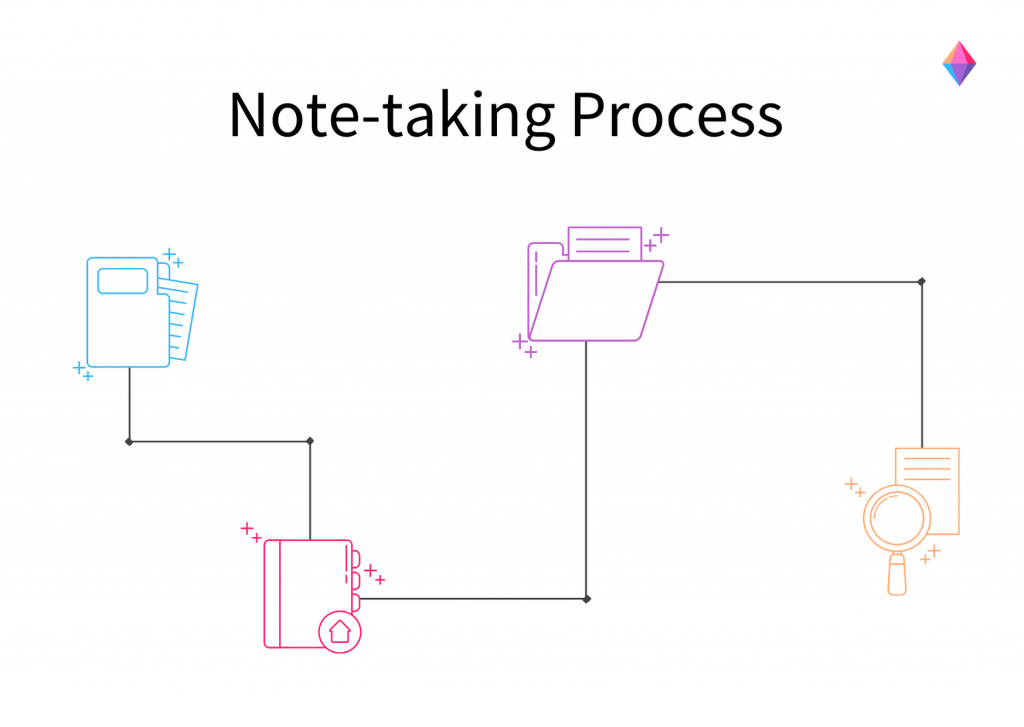
Make sure to understand how your brain analyzes information best before adjusting your note-taking habits. You can certainly employ ‘learning by doing’, but you might end up backtracking, reorganizing, and renaming files to fit into the categorizing you later decided upon.
The Zettelkasten method is about optimizing your workflow of learning and producing knowledge. Figure out your learning and note-taking style and be consistent in applying the steps in the Zettelkasten method:
Step 1: Read and take smart notes
When working, write down your thoughts and the reason why you are taking particular note of a piece of information. This way, you will better understand the focus and reasoning behind the information you jot down. Even better, summarize the information and write it in your own words as much as you can.
Step 2: Rewrite your notes for the Zettelkasten
Once you have collected and summarized the information, it’s time to highlight some key elements. Include index information like the author’s name, book location, or the link URL. For longer Zettels, highlighting the learning objectives or key points in a bullet list might be helpful. The main point is to write your notes in such a way that you will easily be able to quickly get the gist of the material when you come across it again.
Step 3: Adding a structure to your Zettel
The objective of using the Zettelkasten method is to make knowledge relationships. Add a particular #category or number-ID to the individual Zettels to help you link them to another in your system. Doing so will allow you to jump from a related idea or piece of information to the next without having to search through your archive for particular keywords.
You may come to a point where your database is filled with Zettels, expertly organized and linked to another, but you have lost the overview. In this case, you can create Hub notes to help you. Hub notes are Zettels about a certain topic with subtopics. They are similar to the index or the table of contents. Use hub notes as a reference or index for your work. Write down the list of topics in your Zettelkasten with a description and reference number to help you find and access information easier and quicker.
Step 4: Ask questions and review as a habit
Note-taking or note-collecting is great, but having access to a significant amount of information doesn’t make you smarter. Ask yourself questions when analyzing the information to help you develop your own ideas for the content or material. Make it a regular habit to review information in your Zettelkasten to jog your memory and encourage you to see patterns and create connections between ideas and information.
How to Implement the Zettelkasten Method Into Your Workflow
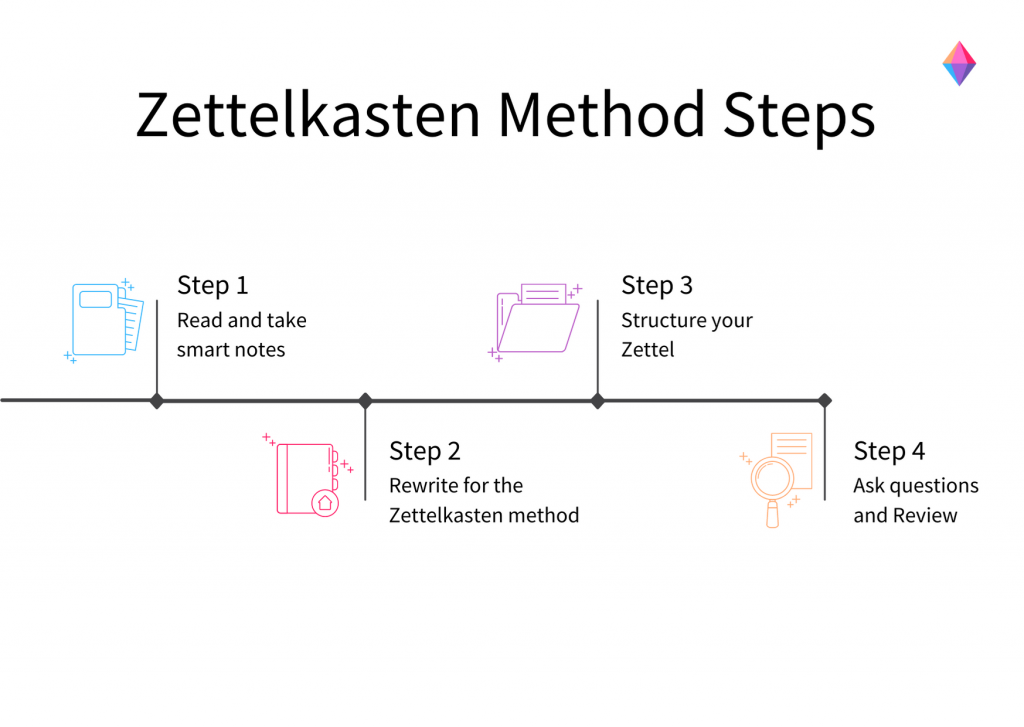
As mentioned, the steps and techniques in the Zettelkasten method are to help you retain your knowledge and develop new ideas. This means that you can use tools and software and tailor the functions to structure how your thought process works.
Selection of Zettelkasten method types:
- Software-based Zettelkasten: It’s certainly super handy having all your notes in digital form. Instead of adjusting and renaming your folder structure on your computer, you could consider using a knowledge management software (psst, Hypernotes!) that uses the Zettelkasten method. Software-based Zettelkasten already have integrated features to make smart note-taking so much easier, such as auto-connecting related notes, and syncing to multiple devices.
- Paper-based Zettel: You may enjoy the manual practice of writing down information and keeping index cards in a folder or designated filing cabinet in your home. Just because it isn’t digital, doesn’t mean you’re not going to be productive (Niklas Luhmann is proof of this!).
- Archive / DocuWiki: If you’re not picky on the design or format and value the text-based information, using a DocuWiki as a Zettelkasten might be right for you. DokuWikis store plain text filled with simple markup locally in a folder on your computer and use the renaming function to create folders as document categories, just like drawers in a filing cabinet.
Whichever Zettelkasten type you choose, remember that there is no perfect note-taking system, only the best one suited for you. Just like when creating a second brain, the note-taking system needs to be suited to your personality and workflow to help you be productive and truly efficient.
Tip: Choose a system type that fits your personality and thought process, and is best suited for the type of work you do.
Images from Jan Antonin Kolar and Maksym Kaharlytskyi from Unsplash
Final Thoughts
The Zettelkasten method is an excellent system encouraging the emergent approach to working through information. Setting up a system and organizing a structure that suits you best is the hard part. After the first steps and with continuous practice, you’ll soon be a walking information archive and impress your family, friends and colleagues with your knowledge.
Everyone has a particular system they enjoy. We’d love to know how you take notes and work through your ideas.
Wishing you a productive lifetime of smart note-taking!
Cheers,
Jessica and the Zenkit Team
FREE 20 MIN. CONSULTATION WITH A PROJECT MANAGEMENT EXPERT
Wanna see how to simplify your workflow with Zenkit in less than a day?
Book a Live Demo
I’ve been zettelkastening for years and now I’ve named it. Thanx
Hey John,
We’re glad to hear you’ve been able to put a name to the process!
We hope the article has proved useful for you.
Wishing you all the best with your Zettelkastening.
Very good blog! Do you have any helpful hints for aspiring
writers? I’m hoping to start my own website soon but I’m a little lost on everything.
Would you recommend starting with a free platform like WordPress or go for a paid
option? There are so many choices out there that I’m totally overwhelmed
.. Any ideas? Thanks!
Hey there!
We find that WordPress is a great place to start writing. It’s internationally well-known and is also very easy to write, add, and edit content.
Good luck 🙂
Very good post. I am going through some of
these issues as well..
Oh my goodness! Impressive article dude! Thanks, However I am experiencing difficulties with your RSS.
I don’t understand why I can’t subscribe to it.
Is there anyone else having identical RSS problems?
Anyone that knows the solution can you kindly
respond? Thanks!!
When someone writes an post he/she retains the thought of a user
in his/her mind that how a user can understand it. Thus that’s why this
piece of writing is great. Thanks!
Thanks for your marvelous posting! I genuinely enjoyed reading it, you’re a great author.
I will be sure to bookmark your blog and definitely will
come back later in life. I want to encourage you to continue
your great posts, have a nice holiday weekend!
Definitely believe that which you stated. Your favorite justification seemed to be
on the web the simplest thing to be aware of. I say to you, I certainly get annoyed while people consider
worries that they just do not know about. You managed
to hit the nail upon the top and also defined out the whole thing without having side-effects , people
can take a signal. Will likely be back to get more. Thanks
whoah this blog is wonderful i really like studying your articles.
Keep up the great work! You recognize, many persons are hunting round for this information, you can help them
greatly.
Greate article. Keep writing such kind of information on your page.
Im really impressed by it.
Hello there, You have done a great job. I will definitely digg it and in my view suggest to my friends.
I am confident they will be benefited from this site.
Nice respond in return of this query with genuine arguments and describing everything concerning
that.
Hello There. I found your blog using msn. This is a really well written article.
I will be sure to bookmark it and return to read more of your useful information. Thanks
for the post. I’ll definitely comeback.
Hi Jessica, thanks for this awesome overview of the zettelkasten method. I really liked how you included the process step of “adding structure to your zettelkasten.” This is so important, but I’ve never seen anyone define it as a step on its own. This makes me want to take more seriously making connections within my notes. Thanks again!
Woah! I’m really digging the template/theme of this blog.
It’s simple, yet effective. A lot of times it’s very
hard to get that “perfect balance” between usability
and visual appeal. I must say you’ve done a superb job with this.
In addition, the blog loads super quick for me on Internet explorer.
Outstanding Blog!
What’s up, every time i used to check website posts here early in the morning, because
i enjoy to learn more and more.
First off I want to say great blog! I had a quick question which I’d like to ask if you do not mind.
I was curious to find out how you center yourself and clear your head before writing.
I’ve had a tough time clearing my thoughts in getting
my thoughts out there. I do take pleasure in writing however it just seems like the first 10 to 15 minutes are lost simply just trying to
figure out how to begin. Any ideas or tips? Kudos!
That’s a really good question!
I’d recommend giving this article a read: https://waysto.digital/how-to-clear-your-head-before-writing/
It offers some really useful tips that I use when I need to write something long or/& complex.
I’ve always found that it’s the distractions that keep me from writing. As soon as I can create a comforting environment (e.g. not too loud, no music (or sometimes low classical music is a good exception)), I find myself being able to feel more inspired &, most importantly, motivated to get writing.
I hope this helps!
Do reach out again if you manage to find something that works for you 🙂
I do agree with all of the ideas you’ve introduced on your post.
They are really convincing and will certainly work. Still, the posts are very brief for beginners.
May you please prolong them a bit from next time? Thanks for the post.
Your style is unique compared to other people I’ve read stuff from.
Thank you for posting when you have the opportunity,
Guess I will just bookmark this page.
I have been reading out many of your stories and i can state clever stuff. I will definitely bookmark your site.
Wow that was strange. I just wrote an very long comment
but after I clicked submit my comment didn’t appear. Grrrr…
well I’m not writing all that over again. Anyway, just wanted to say excellent blog!
I like what you guys tend to be up too. This sort of clever work
and exposure! Keep up the terrific works guys I’ve included
you guys to our blogroll.
We’re glad that you found it so informative!
Many thanks for the kind words 🙂
Thankfulness to my father who told me about this webpage, this website is
truly amazing.
Hi there, I discovered your web site via Google even as looking for
a related topic, your website got here up, it seems great.
I’ve bookmarked it in my google bookmarks.
Hi there, just changed into aware of your blog via Google, and found that it’s really informative.
I am gonna be careful for brussels. I’ll appreciate for those who continue this in future.
Numerous folks will probably be benefited from your writing.
Cheers!
Woah! I’m really digging the template/theme of this site.
It’s simple, yet effective. A lot of times it’s tough to
get that “perfect balance” between user friendliness
and appearance. I must say that you’ve done
a fantastic job with this. Also, the blog loads super quick for me on Safari.
Excellent Blog!
I couldn’t resist commenting. Exceptionally well written!
you are in point of fact a just right webmaster.
The web site loading speed is amazing. It kind of feels that you
are doing any distinctive trick. Also, The contents are masterpiece.
you have performed a magnificent job in this
topic!
Quality articles is the main to attract the visitors to pay a quick visit the website, that’s what this site is providing.
I every time emailed this web site post page to all my associates, since if like to
read it after that my links will too.
Thanks , I have recently been looking for info approximately this subject for a while and yours is the
best I’ve came upon till now. But, what about the bottom line?
Are you certain in regards to the supply?
It’s an amazing paragraph in favor of all the web users; they will take benefit from it I am sure.
What’s up to every one, the contents existing at this site are in fact
remarkable for people knowledge, well, keep up the good work fellows.
Thanks for the kind words!
I was suggested this website by my cousin. I’m not sure whether
this post is written by him as nobody else know such
detailed about my problem. You’re amazing! Thanks!
That’s wonderful to hear!
Many thanks for the kind words 🙂
It is not my first time to visit this site, i am visiting this web site dailly and
obtain good data from here daily.
That’s great to hear!
If you have anything that you’d like to see us cover, do let us know 🙂
Aw, this was a really nice post. Spending some time and actual effort
to generate a good article… but what can I say… I hesitate a whole lot and never seem to
get anything done.
We’re glad that we can provide some useful insight for you!
This was an interesting read. However, it describes a process very much analagous to that long used by librarians but in a much broader and more coordinated way. In other words, it seems very much to be ‘re-inventing the wheel’.
Whilst I accept and value having a clear, relevant & accessible process for useful note-taking and the conservation of those notes together with their intent, context and source, my view is that the personalisation of this process is one better performed by mind-mapping. The formalisation or organisation of information collected, which is in my view what the Zettelkasten method achieves, is better served by a less personalised system that readily fits with already ubiquitous and well maintained systems that connect the universe of information and ideas and the people that have them with one another. Such a ‘non-personal’ system provides much wider scope for serendipity and connection with sources that may otherwise go undiscovered.
The Zettelkasten method is, in my view, a well intentioned but work intensive, intrusive and inherently *disorganised* system that parallels, somewhat poorly, the classification and cataloguing systems used in library and knowledge management.
On the surface, your explanation of the Zettelkasten method and how to use it is an enthusiastic one that presents the method as fairly simple and staightforward to use. In my view, that is an over-simplificaton. I say this not in a mean or derogatory way but because it fails to recognise or elucidate the complexity of relationship building or even, indeed, initial ‘tagging’, i.e. identification of a piece of information, such that all of its potential connections are considered, as well as where and how it fits into the system’s internal organisation and with how complex multiple relationships, blind alleys and false trails can be handled. The system also fails to deal with the fundamental issue of the conflict between specifying a specific place for a concept such that all such concepts, (notes of them in this case), are brought together, and providing as many access points as are necessary to facilitate possible enquiry terminology or viewpoints at a later date.
Library and knowledge management practitioners have wrestled with these and many other relevant issues of which there are far too many to list here, for as long as information has been recorded with the intent of conserving, sharing, linking and accessing it. They continue to do so today, as new concepts, ideas and processes come about and both innovation and obsolescence have to be incorporated into any system that is able to deal with the changes effectively.
It may be that, because the system discussed is focused on note-taking and intended to facilitate a substantially personalised system, readers may consider my comments irrelevant to the piece. That’s o.k., I can understand why such a reaction may exist. However, I’d suggest that it is a flawed one.
Even if such a system is only ever created by a single person and only ever intended to be used by that person, the reality is that it is still a shared system. In effect, one is sharing information, over space & time with oneself. However, that ‘oneself’ is constantly changing & developing and experiencing not only internal but external changes. Indeed, this is one of the reasons that we ‘forget’ information that we have noted and that may even have had a profound effect on us when first recorded. So, of course, my point is that the ‘person’ originally making the note is unlikely to be the same ‘person’ as the one accessing it later, even though they are the same human-being. – Hence the ‘sharing’.
The responses to the article are very positive and I have no wish to detract from that. This comment is not an attack or a complaint. Rather, I wonder how many of those who made positive initial comments and even, in some cases, said they would use the system, have actually done so and how they faired?
My instinct tells me that whilst all or the vast majority will have learned from your article and often been inspired to improve or add organisation to their note-taking, many will also have found difficulty and frustration in attempting to implement and maintain a useful Zettelkasten system for any length of time.
If I am wrong than all well and good. I will have increased my learning, too, and have to re-assess my own thoughts.
Thank you for publicising this on your blog.
We’re glad that you’ve found our post so informative!
You also have an interesting take on the Zettelkasten method.
We always appreciate hearing other people’s perspectives, so many thanks for sharing 🙂
Wow, this post is pleasant, my sister is analyzing such things, thus I am going to
inform her.
Do you have a spam problem on this site; I also am a blogger, and I
was curious about your situation; we have created some
nice procedures and we are looking to swap strategies with others, why not shoot
me an email if interested.
Hi there, yes, we do get the occasional spam messages.
Unfortunately (or fortunately depending on your perspective), we have to go through comments manually to filter out anything that’s considered spam.
My brother recommended I would possibly like this web site.
He used to be totally right. This publish actually made my day.
You can not imagine simply how a lot time I had spent for this info!
Thank you!
Howdy outstanding website! Does running a blog like this require a massive amount work?
I have absolutely no expertise in coding but I had been hoping to
start my own blog in the near future. Anyway, should you have any recommendations or
tips for new blog owners please share. I understand this
is off topic however I just had to ask. Appreciate it!
Hey, no worries at all.
We appreciate you reaching out!
We have a small team to help run & maintain our blog as it can certainly take a lot of work.
Knowing what to write about & how to get it out for everyone to see are probably two of the hardest parts of running the blog – and making sure that you communicate with your audience of course 😉
My recommendation to you would be to start writing about something that your passionate about! Once you get started & find your niche & writing style, everything else should come easily!
In terms of writing platforms, we obviously use WordPress as it’s very user-friendly & easy to navigate. Plus, it helps a lot with maintaining our tone of writing & editing our work if need be.
Hope this helps!
Feel free to reach out again if you have any further questions 🙂
You’re so cool! I don’t believe I have read anything like this before.
So wonderful to discover someone with some original
thoughts on this subject. Really.. thank you for starting this up.
This website is one thing that is needed on the internet, someone with a bit
of originality!
We’re glad that we can provide you with some insightful & useful information!
If you have any thoughts or ideas on what you’d like to see us take a look at in the future do let us know 🙂
Hi there to every one, it’s truly a nice for
me to visit this web page, it includes helpful
Information.
Howdy! I simply would like to offer you a huge thumbs up for your great info
you’ve got right here on this post. I will be coming back
to your web site for more soon.
Hi there, we’re glad that we can offer you some useful insight!
We’re glad to have you around 🙂
Hi there, for all time i used to check webpage posts here early in the daylight, as
i love to gain knowledge of more and more.
Well, we hope you find something of use here!
you’re in point of fact a excellent webmaster. The site loading speed is amazing.
It sort of feels that you’re doing any distinctive trick.
In addition, The contents are masterpiece. you have done a fantastic process in this subject!
I don’t know whether it’s just me or if perhaps everybody else encountering problems with
your site. It appears as if some of the written text in your content
are running off the screen. Can someone else please provide feedback and let me
know if this is happening to them too? This might
be a problem with my internet browser because I’ve had this happen before.
Cheers
Hi there, we’ve just checked from our end and we can’t see anything out of place!
Perhaps try a different browser? 🙂
So start out early and set up excellent habits for the future.
You inspire me…though you are extremely young..But age is
not a aspect for that.
Hi! This post could not be written any better!
Reading through this post reminds me of my good old room mate!
He always kept talking about this. I will forward this
page to him. Pretty sure he will have a good read.
Thanks for sharing!
That’s great to hear!
We hope they enjoy reading it as much as you did 🙂
A person essentially lend a hand to make seriously articles I’d state.
This is the first time I frequented your website page and up to
now? I amazed with the analysis you made to make this actual
post incredible. Magnificent job!
I’m glad that we can provide you something useful!
Thank you for the kind words 🙂
For instance, in 2009 to 2015, 93.6 % of those who played
football were guys.
I really like what you guys are up too. This kind of clever
work and coverage! Keep up the awesome works guys I’ve
included you guys to my personal blogroll.
Hi there, thank you for the kind words!
We look forward to keep on knowledge sharing with you 🙂
I love your blog.. very nice colors & theme. Did
you design this website yourself or did you hire someone to do it for you?
Plz respond as I’m looking to design my own blog and would like to know where u got this from.
kudos
Hi there, someone on our team has put everything on our website together!
Wow, that’s what I was looking for, what a data! present here at this web
site, thanks admin of this web page.
This is my first time visit at here and i am truly happy to read all at single place.
It’s nearly impossible to find well-informed people in this
particular subject, however, you seem like you know what you’re talking about!
Thanks
After looking into a handful of the blog posts on your web page, I really appreciate your technique of writing a blog.
I book-marked it to my bookmark website list and will be checking back soon. Please check out
my web site too and let me know what you think.
Whats up very cool web site!! Guy .. Beautiful .. Amazing ..
I will bookmark your blog and take the feeds additionally?
I’m satisfied to seek out a lot of useful info right
here within the publish, we want develop extra strategies in this regard, thanks for sharing.
. . . . .
Have you ever thought about publishing an e-book or guest
authoring on other websites? I have a blog based on the
same ideas you discuss and would really like to have you share some stories/information. I
know my visitors would appreciate your work. If you’re even remotely interested, feel free to send me an e-mail.
Hi There,
Yes, we have been discussing the idea of releasing an e-book & guest authoring on third-party websites.
However, these are ideas that we are still discussing internally, but we appreciate you reaching out to us. Should this be something of interest to us, we’ll be sure to get in touch 🙂
This was great for learning about Zettelkasten! Thank you! I’m going to start right now and my first literature note will be this blog post! 👍🏼
Thanks for the article. I have a question for you. In a paper-database-system like Luhmnn worked how did he could link a new note with one or more of those thousand notes previously written if he had only alphanumeric ID?
A separate register of ‘generalized’ keywords is used which provides links to previous associated notes. Without the use of a keyword register you could end up with a lot of lost or unlinked notes. The keyword register needs to be regularly updated as the system grows. Additional links between notes can be made any time they are discovered or referenced in the system.
Why don’t you create this in Hypernotes and make available for public download? In fact, a lot of your blog posts could be made into Hypernotes and made available publicly. It would probably help with adoption and promotion.
It would be nice if we had some examples of how to set up a few pages in my Zettelkasten. I am a pastor and want to setup a Bible knowledge base with commentaries on Bible verses and topics.
Blessings Pastor Mick
Hello Pastor Mick,
Thank you for your feedback and suggestion. Our content team certainly is thinking about variations and use cases to write about. Are there any specific questions or struggles you have concerning setting up your Zettelkasten system that would be helpful if we were to address?
Regards,
Jessica